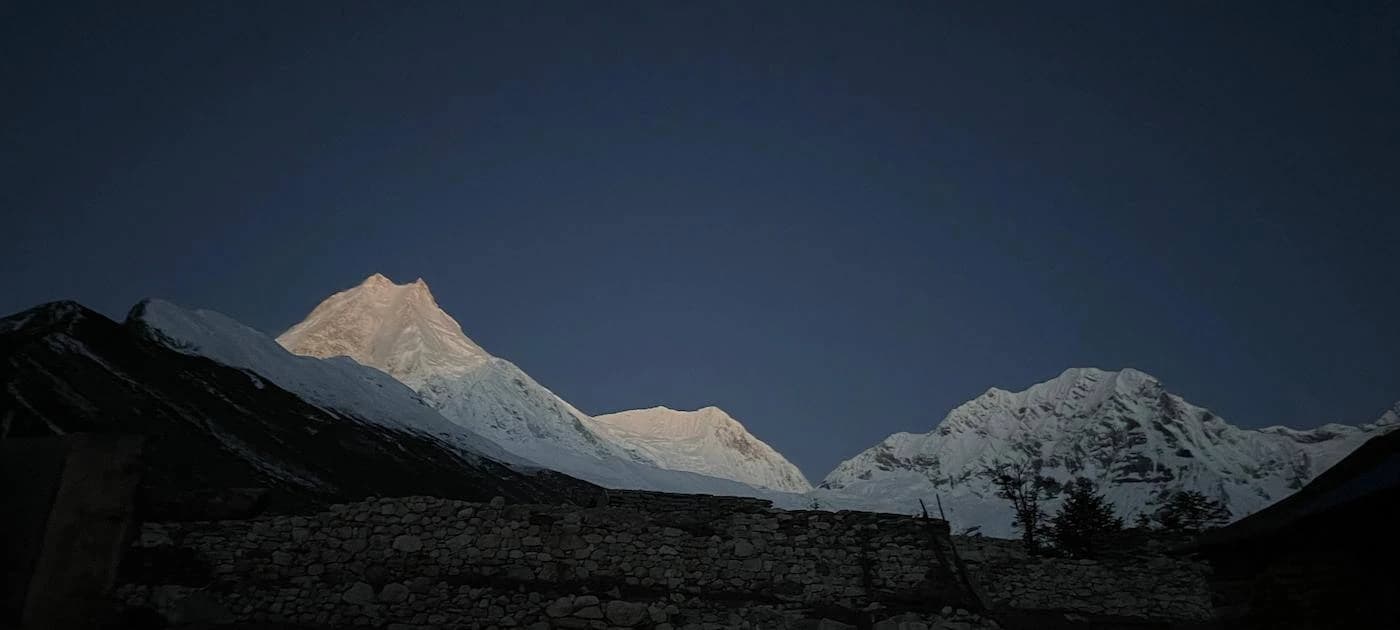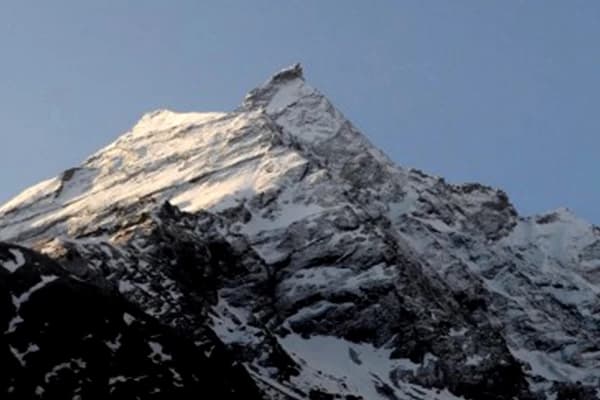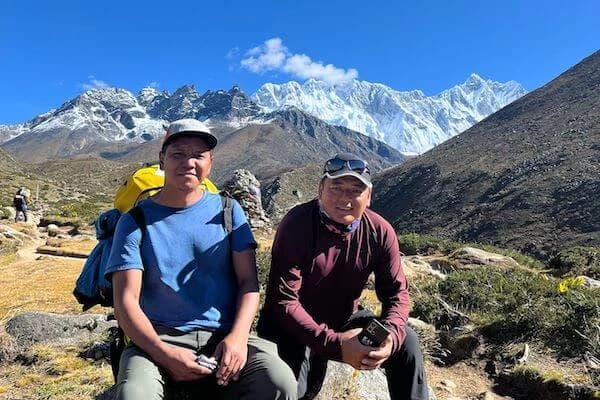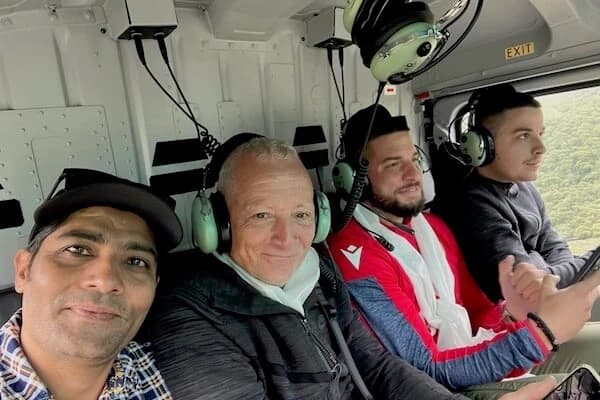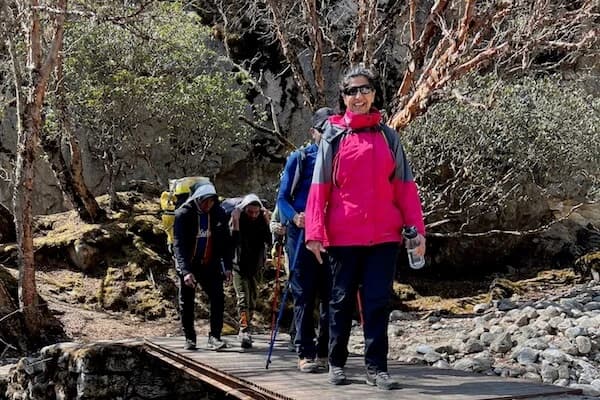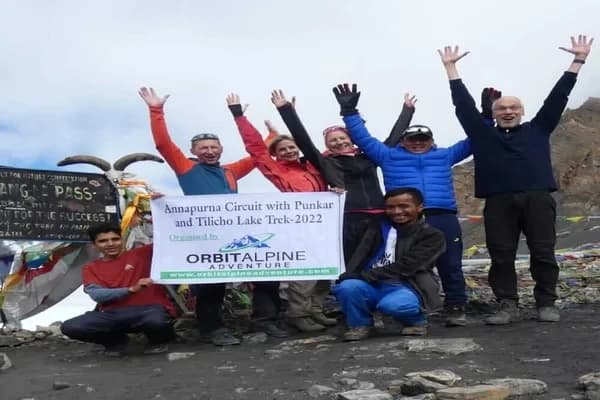The Manaslu Trek is named after the eighth highest peak, known as Mount Manaslu, at a height of 8,163 meters. It cuts across unspoiled valleys, dense forests, traditional Tibetan villages, and various terrains that range from subtropical forests to mountainous heights. The Manaslu Circuit Trek is also one of the wildest and most amazingly beautiful walks in Nepal-an incomparable exploration for those travelers in search of an unparalleled combination of wild Himalayan sceneries, rich cultural encounters, and challenging high-altitude passes. The highlight of the trek is a crossing of the Larkya La Pass at 5,106 meters, one of the highest and most enormously viewable passes in the region, affording the most remarkable view to the nearby peaks.
Best Time for Manaslu Circuit Trek with Best Itinerary
Searching for less crowded than other famous treks, such as Everest Base Camp and Annapurna Circuit? Explore Manaslu Circuit trek. This region offers more peaceful and personal time to the trekkers. The area was opened to the trekkers in the early 1990s, and being a restricted area, special permits along with having a licensed guide have been helpful in keeping the natural and cultural heritage well-preserved.
The trek is considered moderately hard, though it generally takes 14 to 18 days to complete depending on acclimatization and side trips. One sees villages and passes during the trek where Tibetan Buddhism is followed by old monasteries, Mani walls, and a line-up of prayer flags. The majority of the local people are of Tibetan ancestry and greet every trekker with a lot of warmth. This setting makes the depth of culture attached with the trek greater.
Best Time to Trek
Timing is everything in the Manaslu Circuit Trek so that its beauty and adventure can be enhanced. Each of these seasons has its magic, but generally, these autumn and spring months are considered good because one gets to enjoy clear skies, moderate temperatures, and wonderful views. This trek is best for those who are in search of something off the normal tracks, having just the right combination of nature, culture, and challenge.
1. Autumn (September to November) - Best Time
Autumn, in general, is considered the best time for the Manaslu Circuit Trek since it comes with near-perfect conditions. Starting from September and lasting until November, it falls immediately after the monsoon rains have washed away, leaving the skies clear, crisp air, and freshened sceneries. This is the most popular time to go trekking in Nepal, and rightly so.
Weather Conditions
Autumn is the most steady and comfortable time for a trek in the Manaslu region. Heavy rains during monsoon clear dust from the atmosphere, making visibility brilliant with crystal clear skies. At lower altitude, during the day, it is pleasingly warm with temperatures between 10°C to 20°C, allowing comfortable trekking, while at high altitudes, it is cooler, and in the night, generally below freezing, particularly above 3,500 meters. The nights get really chilling, especially around Larkya La Pass, which is 5,106 meters above sea level, and the temperature plunges to as low as -10°C or even below that. During autumn, conditions stay dry and mild, and hence the possibilities of rainfall, landslides, and slippery trails are quite different, as it happens very often during the monsoon season. Besides, the trekking route remains almost snow-free until late November, making crossways over the inspiring Larkya La Pass very easy.
Beautiful Views and Scenic Beauty
Other important reasons autumn is the best time for the Manaslu Circuit Trek are for the amazingly clear mountain views. The snow-capped peaks of Mt. Manaslu, Himalchuli, and Ngadi Chuli will fall in easy sight, all along the route, besides other high mountains above them. The post-monsoon air is fresh and has added sharpness to the views; trekkers get some of the most breathtaking views in the Himalayas as a result.
The path down, the valleys, forests, and fields arise in emerald green after the monsoon rains, all combining in an exciting contrast against the white peaks. Rhododendron and pine forests dot the lower regions, taking on golden hues through autumn in the season.
Cultural and Festival Experience
Autumn also coincides with the major festivals of Nepal, Dashain, and Tihar. These are celebrated with immense energy throughout the country, from urban areas to the far-flung mountain villages. This automatically becomes another experience to trek at this time of the year as Gurungs, Tibetans, and other ethnic people celebrate these important cultural events. You would witness and be a part of these events personally.
Crowds and Availability
While autumn is the high season, the Manaslu Circuit is by no means crowded compared to more well-trodden Everest Base Camp or Annapurna Circuit treks. You will surely come across quite a few fellow trekkers but far from crowds, where an impression of isolation and adventure can still be maintained.
2. Spring-March to May: Second Best Time
Spring, covering the periods from March to May, is considered the second-best time to make this Manaslu Circuit Trek. During this time of the year, the trekker gets mild weather, exciting scenery, and excellent visibility of the high Himalaya peaks. Especially for nature lovers, the flora of the region starts coming alive with blooms of rhododendrons and lush green forests, adding colors and scenic magnificence throughout the journey.
Weather Conditions
Warmer temperatures, along with more steady weather in the Manaslu region, make spring a better period to trek than in the cold season. Moving from daytime temperatures of 10°C to 25°C at lower altitudes, the higher altitudes have daytime temperatures from -6°C to 12°C. Generally, temperatures are usually mild during the day, although the temperatures fall at night, yet not as exciting as in winter.
Minimal rainfall records during the spring season, mainly in the months of March and April. On the contrary, the pre-monsoon showers can always attack in the last month, May. However, they are usually light showers that barely create a problem for trekking. Generally, the weather remains steady enough to negotiate the tough passage over Larkya La Pass at 5,106 meters. However, it is a possibility that early May may be tricky due to heavy snow accumulation.
This spring is especially known for rhododendron blooms, lighting the forests in the trek route. These rhododendrons grow into fully grown trees and paint the hill sides with colors in a medley manner. Along with the rhododendrons, many other wildflowers and trees start growing and create an outstanding contrast on the snow-white backdrop of peaks like Mount Manaslu and Himalchuli. The dry winter recovers the lavish green dress of the valleys, forests, and fields.
Besides the bloomy beauty, spring offers crystal-clear skies and remarkable views of the mountain ranges, mainly in the early morning and late afternoon. Manaslu and its neighbors arise completely into view; thus, this is the best time for photography and all-around views.
Cultural Experiences
Like autumn, the spring season also allows trekkers to perceive and participate in the rich textile of culture in the Manaslu region. These are ethnic villages along the route, populated by the Gurung and Tibetan people among others, and spring is a good time of year to catch sights of the original way of life. The villages are humming with activities of preparation for the planting season, and trekking allows interaction with the locals in their day-to-day lives. Most trekkers also visit monasteries and Mani walls for an inspiring cultural experience.
Crowds and Availability
Despite spring being the high season to go trekking, the Manaslu Circuit sees fewer trekkers than either the Everest or Annapurna regions. The trails will be moderately busy - a sense of harmony between other trekkers but without the feeling of overloading that happens on the more commercial routes from other treks.
3. Winter (December to February) - Challenging but Peaceful
Winter has really cold temperatures, especially at altitudes. The day temperature of the altitudes lying below 2,500 meters ranges between 5° to 10°, while in higher altitudes, it severely goes down at a rate of -10° or even less from the day temperature and is quite cold during night times and out of the sun areas. Temperatures at night near the Larkya La Pass at 5,106 meters reach -20°C or even less, making the trek pretty challenging.
Heavy snows usually start in December and January, which makes parts of the trek difficult and closed above 3,500 meters. This is usually the time when the Larkya La Pass can get closed because of extreme snowfall and dangerous conditions. However, the lower parts of the trek remain clear, with less effect from snow gathering, and it may be a quiet time with few trekkers to enjoy the special beauty of winter sceneries.
Scenic Beauty and Solitude
The best rewards for trekking the Manaslu Circuit in winter are loneliness and peacefulness. The paths are almost empty, offering a calm, serene trek with no crowds, like during the peak season. The whole region appears to be pure, with fresh snow layers on mountains, forests, and villages, thereby turning the scenery into some heavenly beauty.
These are much more remarkable during winter, as the peaks of Mount Manaslu, Himalchuli, and other nearby peaks afford clear, unrestricted views on crisp, sunny days. The forests dotted with frost and snow wear an air of fantasy, and frozen rivers and waterfalls add to the incredible views.
Cultural Experience
Although it cuts down the number of trekkers, winter permits more personal interaction with the people living locally. The peoples of this area, mainly Gurung ethnic group, lead their lives preparing for harsh winter months. These trekkers get the opportunity to experience the native's traditional lifestyle, and enjoy the warm hospitality of local tea houses working during off-season, though options are limited.
Challenges and Preparation
Winter trekking requires a lot of preparations. Much cold, snow, and icy paths demand proper gear such as top-notch sleeping bags, a down jacket, and trekking boots that fit for snowy conditions. Physical preparation and experience with high-altitude trekking will be very important in this journey, as huge challenges are ahead, especially for those who plan to make it across the Larkya La Pass. Equally important will be appealing the services of an experienced guide, as mountain conditions can decline within a very short time, and heavy snowfall may make direction finding challenging.
4. Monsoon, June to August - Not Recommended
The worst recommendation for the start of the Manaslu Circuit Trek would be during the monsoon season that falls in the months of June, July, and August due to disapproving weather conditions and threats related to hefty rain. This period receives heavy rainfall throughout this region; hence, trekking becomes more difficult, less enjoyable, and even dangerous at times. Even though the landscapes are greener during this period, the major drawback usually for most trekkers is always balanced by the advantages.
Weather Conditions
The rainfall is heavy and determined, with regular day rain showers lasting from several hours up to a full day. Obviously, this is even heavier in the lower altitude areas; the rainfall in July is normally at its maximum. Although the temperature in lower altitude remains warm, generally between 15° and 25°C, at higher altitudes it is cooler, though wet. The weather is wet, and the humidity is high and rough for trekking.
The rain makes everything on the trail muddy, and thus the chances of sliding or slipping get higher. Besides, in some parts, a landslide is highly expected along narrow and steep paths; this also makes a serious safety threat. The infestation brought by leeches is another distress during the monsoon period, especially in the forests and damp and lower altitude areas.
This season is practically covered by clouds all the time, disguising the views of the magnificent Mount Manaslu, Himalchuli, and other peaks. The great all-around views that form the main attraction for this trek usually get covered behind thick clouds and fog, reducing its overall visual attractiveness.
Flora and Scenic Beauty
While rough, the weather does reward some trekkers who don't mind getting wet with some great prizes. The rain forces the scenery into a lush emerald green, with forests, fields, and hillside making their claims of life. Waterfalls and rivers are at their most dramatic and powerful, offering a natural scenery of drama. Oftentimes, the discomfort and the danger brought about by rain overshadow this.
Cultural Experience
Trekking routes are at their least crowded during the monsoon. It is only those who can bear through the rain that get to experience cultures up close. The villages along the route will not be crowded because of the less touristy arrivals, which will allow for personal interaction with these communities, both Gurung and Tibetan. This thin season, most of the teahouses and other accommodations close down due to shortage in the number of tourists, which makes finding proper shelter en route relatively difficult.
Challenges and Risks
The monsoon also includes quite a few challenges for the trekkers. Wet and slippery trails demand extra caution, and there is always an impending fear of landslides. Besides, to-and-fro transportation from starting and ending points may get hampered due to road blockages caused by falling boulders or flooding. Higher humidity means the trekking gear and clothes are continuously wet, hence making the trek painful.
Because of this fact, the trek is less scenic but more hazardous with weak visibility; therefore, it will lessen the pleasure of one of the most magnificent routes in Nepal. Without unbroken rainfall and a symbolic view of mountains, Manaslu region loses much of its beauty during the monsoon. It'll be better to consult with Guide to visit Manaslu Base Camp Trek to reduce obstacle and make your travel worth it.
Best Itinerary for the Manaslu Circuit Trek
The Manaslu Circuit Trek itinerary is subject to change depending on acclimatization or the development of good fitness, coupled with weather conditions. Here is an itinerary structure for 18 days, which is a standard safe approach toward making the complete trek, allowing proper acclimatization and time to enjoy the landscapes and culture.
Day 1: Arrive at Kathmandu
Activities: Upon your arrival, transfer to your hotel and rest. Preparation for the trek. If time permits, then take a visit around some UNESCO World Heritage Sites in Kathmandu: Swayambhunath, famous as the Monkey Temple, and Boudhanath Stupa.
- Altitude: 1,350 meters
- Accommodation: Hotel in Kathmandu
Day 2: Kathmandu to Soti Khola (700 meters) – 8-9 hours
Drive: Long drive from Kathmandu to Soti Khola via Arughat - both paved road driving and off-road conditions. Scenic views of the Trishuli River and hills can be seen en-route.
- Altitude: 700m
- Accommodation: Tea house in Soti Khola
Day 3: Soti Khola to Machha Khola (869 meters)-6-7 hours
Trek: Wholly immersed in the trek down the Budhi Gandaki River, through forests of rice paddies, scattered villages, across suspension bridges, and upwards onto forested ridges.
- Altitude: 869m
- Accommodation: Tea house in Machha Khola
Day 4: Machha Khola to Jagat (1,340 meters) – 6-7 hours
Trek: The complete submergence of the river on gradual ascents and descents leads to a pass through the hot springs at Tatopani, with an upward trek to Jagat, where permits are checked.
- Altitude: 1340 meters
- Accommodation: Tea house in Jagat
Day 5: Jagat to Deng (1,860m) - 6-7 hours
Trek: Gradually ascend through forests and several suspension bridges, this area leads via villages of Philim, Ekle Bhatti, and reaches Deng- a small Gurung village.
- Altitude: 1,860 meters
- Accommodation: Deng Tea House
Day 6: Deng to Namrung (2,630m) - 6-7 hours
Hike: Altitude gains and marked topographical and cultural variations. The remains of Tibetan Buddhism begin to appear when the trek edges closer to Namrung.
- Elevation: 2,630 meters
- Overnight: Tea house in Namrung
Day 7: Namrung to Samagaon (3,520 meters) -7-8 hours
Trek: Hike through alpine forests and pass by several monasteries en-route, glimpses of Mt. Manaslu peaks falling on the way. Continue on the trail to Samagaon, one of the bigger villages influenced by Tibetans.
- Altitude: 3,520 meters
- Accommodation: Tea house in Samagaon
Day 8: Acclimatization Day at Samagaon
Activities: This is a compulsory day to get acclimatized with this high altitude. One can visit Pungyen Gompa or can take a short hike to Manaslu base camp 4400 meters if felt strong.
- Accommodation: Tea house in Samagaon
Day 9: Samagaon to Samdo (3875meters) - 3 - 4 hours
Trek: A shorter trekking day to allow further acclimatization. The trail now ascends gently offering magnificent views of the surrounding peaks. Reach the small Tibetan settlement of Samdo.
- Altitude : 3875 m
- A pleasant night in: Tea house in Samdo
Day 10: Acclimatization Day in Samdo
February: These days you can have your own time to relax or a short hike toward the Tibetan border or the valley above Samdo with a panoramic mountain view.
- A pleasant night in: Tea house in Samdo
Day 11: Samdo to Dharmashala/Larkya Phedi (4,460 meters) – 4-5 hours
Day Trek: Gradual ascend to Dharmashala, which is the last stoppage before crossing the Larkya La Pass. The trail follows through a beautiful valley with great views of Larkya Peak and other surrounding mountains.
- Altitude: 4,460 meters
- Accommodation: Tea house in Dharmashala
Day 12: Dharmashala to Bimthang (3,720 meters) via Larkya La Pass (5,106 meters) - 8-9 hours
Trek: The most challenging day of the trek. Start early in order to cross the Larkya La Pass that boasts some outstanding views of Mount Himlung, Cheo Himal, Kang Guru, and Annapurna II. Descend to Bimthang after crossing the pass.
- Altitude: 5,106 m (Larkya La Pass), 3,720 m (Bimthang)
- Accommodation: Tea house in Bimthang
Day 13: Bimthang to Tilije (2,300 meters) - 6-7 hours
Trek: Down through forests of pine and rhododendron, and see views of the Manaslu and Annapurna ranges. Arrive at the beautiful village of Tilije.
- Altitude: 2,300 meters
- Accommodation: Tea house in Tilije
Day 14: Tilije to Dharapani (1,860 meters) - 4-5 hours
Trek: A relatively easy down towards Dharapani, from where the trail will meet up with the Annapurna Circuit Trail.
- Altitude: 1,860 meters
- Accommodation: Tea house in Dharapani
Day 15: Dharapani to Besisahar (760 meters) – 6-7 hours’ drive
Drive: Finishing the trek in Dharapani, take a scenic drive to Besisahar, enjoying the views of terraced fields and villages.
- Altitude: 760 meters
- Accommodation: Tea house in Besisahar
Day 16: Besisahar to Kathmandu – 6-7 hours’ drive
Drive: Drive back to Kathmandu by private car or public bus. Once reached Kathmandu, you are free either to relax at leisure, do some last-minute souvenir shopping, or do more exploration of the city.
- Accommodation: Hotel in Kathmandu
Day 17: Free day in Kathmandu
Activities: This is a possibility for delay due to weather or any other obstacles. Alternatively, it might be used to explore Kathmandu or rest after a long journey.
- Accommodation: Hotel in Kathmandu
Day 18: Departure from Kathmandu
Activities: On this day, we'll say you goodbye from Nepal. We'll offer you malas and some gifts. We'll miss you and wait for you to come again and enjoy with us.
Key Notes for Manaslu Circuit Trek:
-
Permission: The Trek requires special permits. This includes a restricted area permit for Manaslu, Annapurna Conservation Area
-
Permit (ACAP), and Manaslu Conservation Area Permit (MCAP)
- Guide/Porter: The Manaslu Circuit lies in the restricted area; hence, it is compulsorily required to trek with licensed guides. A guide will also be helpful in regard to acclimatisation and may provide knowledge of the local culture and history in an enriched way.
- Acclimatization: Rest and go upwards towards a higher altitude gradually so as not to get sick due to the altitude.
- Physical Rating: The rating for physical fitness is Moderation. Cardio exercises and strength training before going on a trek will be very helpful. The 18-day trekking program allows for comprehensive trekking, proper acclimatization, gaining insight into the culture, and enjoying the most spectacular landscapes. If one is well prepared, Manaslu Circuit Trek should be among the most rewarding routes to take in Nepal.
- Fast Trek: If you short time but wanna go to travel. You can choose the option Manaslu Short trek.
Conclusion
The Manaslu Circuit Trek is a once-in-a-lifetime trekking adventure over some of the roughest sceneries in the Himalayas, offering exciting trekkers a supreme combination of nature's beauty, rich cultural experiences, and physical challenge. Basically, September to November-that is, autumn-and spring, involving March to May-are the best months to do this trek because it normally guarantees steady weather with clear views. Winter does isolate it with remarkable snow-covered views, but is decidedly much more difficult, especially higher up.
The worst time is during the monsoon, for it rains and the path condition is not good. As mentioned earlier, the 18-day trek is good for acclimatization and hence safety is guaranteed coupled with full enjoyment of the trek. Filled with moments of great adventure and amazement-from charming villages to ancient monasteries, along with spectacular Larkya La Pass. Proper planning, getting good permits, and trekking with an experienced guide is very important to make this restricted region a successful one. Probably one of the most rewarding treks in Nepal for a trekker who enjoys a bit of trekking outside of mainstream trails, the Manaslu Circuit offers mountain majesty deeply immersed with cultural combination.
Frequently Asked Questions
1. How long does it take for Manaslu Circuit Trek?
It is normally a 14- to 18-day trek from the various kinds of itinerary plans. Hence, this time comprises actual trekking days, rest days for acclimatization, and the time needed while traveling to and from the trailhead. Therefore, this time ideally may be when the Manaslu Circuit can be undertaken. Note the following:
2. Best Time to Trek Manaslu Circuit?
The best time for the Manaslu Circuit Trek is during the Autumn season and during the last three months of the year. By that time, the skies clear up, are stable, and pleasant in terms of temperatures.
3. Do I need a guide for the Manaslu Circuit Trek?
Yes, the Manaslu Circuit Trek needs to hire a licensed guide. Actually, the route is within the restricted area, and the government of Nepal expects guides and special permission for trekkers.
4. How difficult does the Manaslu Circuit Trek have?
The trekking grade for this circuit is regarded as a middle-grade, which incorporates good bodily fitness to bear long days of trekking, high altitude as high as 5,106 meters at Larkya La Pass, steep ascents, and descends. Proper acclimatization is needed to avoid altitude sickness.
5. Altitude Sickness: Should I be Concerned on this Hike?
Yes, from approximately 3,000 meters onwards, altitude sickness can take effect. The best way to acclimatize is to go uphill very slowly. Also, taking at least a few days for acclimatization is recommended in order not to develop serious altitude problems. Such symptoms as headache, nausea, and dizziness are warning symptoms which call for consideration.
6. What is the Accommodation like on Manaslu Circuit?
Accommodation: Primarily tea houses that are simple lodges maintained by the locals. Shared rooms, a bed with a blanket and quite often something to eat. Basic facilities, and even more basic as it goes up in altitude, become limited in terms of electricity, hot water, and Wi-Fi.
7. What level of fitness do I require for the Manaslu Circuit Trek?
Reasonable level of physical fitness is required. You are supposed to be comfortable in a walk of 5 to 7 hours in uneven and rough terrain every day. Basic cardiovascular fitness, leg strength, and stamina for steep climbs and descents and traversing high altitude paths, walking, and trekking.
8. Is the trek crowded?
The Manaslu Circuit is less famous compared to famous treks like Everest Base Camp or the Annapurna Circuit. You will also see other trekkers, but compared with most of Nepal's trekking routes, the trail does offer far more solitude during off-season time and an overwhelming sense of remoteness.
9. Can the Manaslu Circuit Trek be soloed?
No, it's in a restricted area, and quite literally that means you can't trek alone in Manaslu. You're obligated to join a licensed guide, and it's highly recommended to include at least one porter for seeking the assistance of a carrier.
